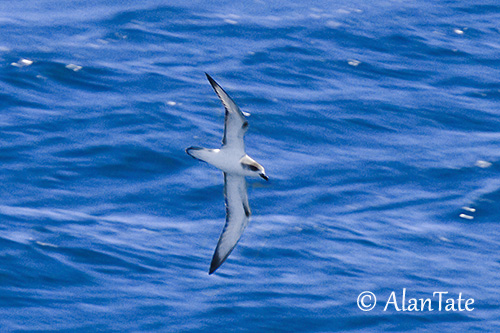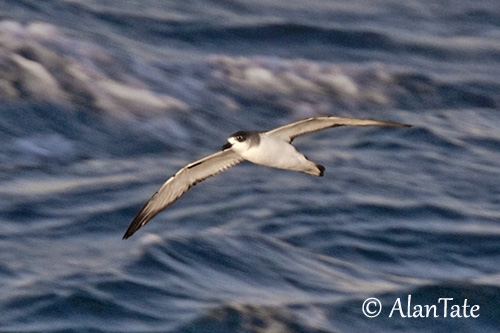
Fr: Pétrel de Juan Fernandez - Diablotin de Juan Fernan - Diablotin de Juan Fernandez
Ang: Juan Fernandez Petrel
All: Robinsonsturmvogel
Esp: Petrel de Las Juan Fernández
Ita: Petrello di Juan Fernandez
Nd: Witnekstormvogel
Sd: juanfernándezpetrell
Photographers:
Alan & Ann Tate
AA Bird Photography
Text by Nicole Bouglouan
Sources:
HANDBOOK OF THE BIRDS OF THE WORLD vol 1 by Josep del Hoyo-Andrew Elliot-Jordi Sargatal - Lynx Edicions - ISBN: 8487334105
Petrels, Albatrosses, and Storm-Petrels of North America: A Photographic Guide De Steve N. G. Howell – Editor: Princeton University Press, 2012 – ISBN: 0691142114, 9780691142111 – 482pages
OISEAUX DE MER – Guide d’identification de Peter Harrison – Editions Broquet (Canada) – ISBN-10 : 2890004090 – ISBN-13 : 978-2890004092
Endemic breeding birds of Juan Fernández archipelago, Chile
Biology and Conservation of the Juan Fernández Archipelago Seabird Community
Population estimates and breeding biology of the petrels Pterodroma externa and P. longirostris on Isla Alejandro Selkirk, Juan Fernandez Archipelago
Wikipedia, the free encyclopaedia
Page family Procellariidae
Summary cards
Juan Fernandez Petrel
Pterodroma externa
Procellariiformes Order - Procellariidae Family
INTRODUCTION:
The Juan Fernandez Petrel is an endemic breeder of Alejandro Selkirk Island (formerly Masafuera Island) in Juan Fernandez Islands, off EC Chile.
It typically nests in burrows on high grounds, between 600 and 1,000 metres of elevation. Following the breeding season, it disperses across central and eastern Pacific.
This species feeds mainly on flying fish and squid, as well as small fish jumping above the surface while being chased by large predator fish.
The Juan Fernandez Petrel is threatened by invasive mammalian predators on the breeding islands, involving significant decline of the population. The species is currently classified as Vulnerable.

DESCRIPTION OF THE BIRD:
Biometrics:
Length: 43-45 cm
Wingspan: 95-114 cm
Weight: 310-555 gr
The Juan Fernandez Petrel is one of the largest gadfly petrels.
The upperparts are silvery-grey with darker wings and tail. In fresh plumage, a distinct M pattern is visible from one wingtip to the other across the lower back, and contrasts with the paler back, mantle and inner forewing.
Rump and tail appear dark, but we can see sometimes a distinct, whitish U-shaped band on the rump.
In worn plumage, the upperwing appears dark.
During the moult period, a narrow, white hind-collar is formed by the pale bases of nape feathers. The rump appears paler too.
The underparts are white, except the dark wingtips and the trailing edge. A small, variable black carpal bar similar to a small, black “comma” is present in front of the elbow joint. The tail feathers have dark tips.
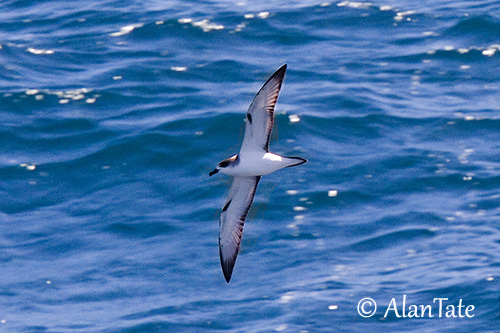
On the head, crown and eye-patch are blackish-grey to dark brown-grey. They are separated from the large bill by the distinct, white forehead, the latter appearing finely spotted dark, due to the blackish bases of the feathers.
Fore face, cheeks, chin and throat are white. There is a large grey patch on neck-sides. It joins the mantle and forms a partial collar.
The bill is black. The eyes are dark brown. Legs and basal part of the feet are pale pink, whereas the outer toes are blackish.
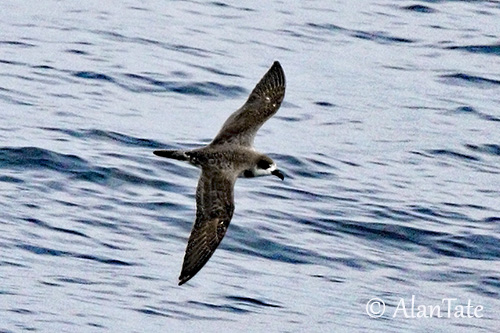
Male and female are similar.
The juvenile resembles adult after the first year during which the young bird shows some differences before to gain the adult plumage.
RANGE:
The Juan Fernandez Petrel breeds on Alejandro Selkirk Island (previously Masafuera Island) in the Juan Fernandez Islands, off EC Chile.
The Archipelago is about 600 kilometres W of Valparaiso, and is separated from the coast of Chile by the Humboldt Current passing powerfully between the island and the mainland.
Outside of breeding season, it disperses extensively across C and E Pacific, and can be seen W across Polynesia and N to Hawaii and Mexican waters. Individuals may range further W to Australia and New Zealand.
HABITAT:
The Juan Fernandez Petrel is highly pelagic and comes to land only to breed on islands. It nests in excavated burrows on slopes and ridges, in fern-forest with Dicksonia externa, and in adjacent grasslands, between 600 and 1,000 metres of elevation.
Outside of breeding season, the species is marine and highly pelagic.
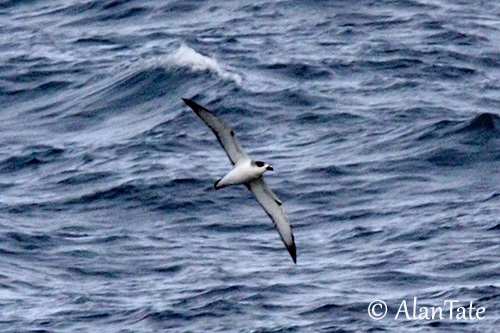
CALLS AND SONGS: SOUNDS BY XENO-CANTO
The Juan Fernandez Petrel gives a whining whistle, sometimes followed by a harsh bark or “wowk” sound while flying at night above the breeding colonies. These sounds are heard during chases between males and females.
It also produces a booming “boo-booo-boo” both from the air and the ground. Some chattering calls are also uttered from the ground, and sometimes when the birds are within the burrow.
BEHAVIOUR IN THE WILD:
The Juan Fernandez Petrel feeds mainly on flying fish and squid caught on or near the sea surface. But it also takes Gonostomatidae and sea skaters (Holobates), the latter probably incidentally.
The prey are caught by surface-seizing, dipping, aerial pursuit and pattering.
The Juan Fernandez Petrel often forages alongside other seabirds in groups of 5-20 individuals, such as other gadfly petrels of genus Pterodroma, boobies (Genus Sula of family Sulidae), terns and sometimes Leach’s Storm-Petrel.
But it also associates with cetaceans driving fish to the water surface where it can catch them.
This species may occasionally fly around fishing boats.
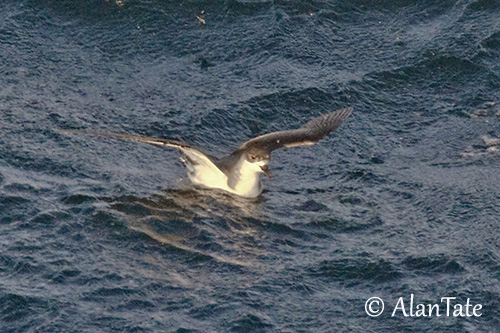
The Juan Fernandez Petrel is a colonial nester. It nests in burrows, also apparently on the surface of the ground. Males and females perform noisy chasing flights at night, while flying over the colonies. Both adults share the nesting duties.
The Juan Fernandez Petrel disperses after the breeding season across C and E Pacific, throughout Chilean waters, W across Polynesia and N to Hawaii and Mexican waters.
Wanderers are recorded in SW Pacific, near SE Australia, Tasmania and New Zealand. Individuals return year after year to the Chatham Islands, apparently prospecting for nesting-sites and possibly breeding.
Vagrants have been recorded W to Japan, N to offshore waters of S Oregon, and inland at Tucson, Arizona.
The Juan Fernandez Petrel has typical gadfly petrel flight and performs an incredibly fast flight. In strong wind conditions, the speed of the flight is estimated at 200km/h, similar to the Peregrine Falcon.
The flight is graceful and effortless with high banking while the wings are held vertically and the carpal joint pushed forwards, interspersed with glides close to the water surface.
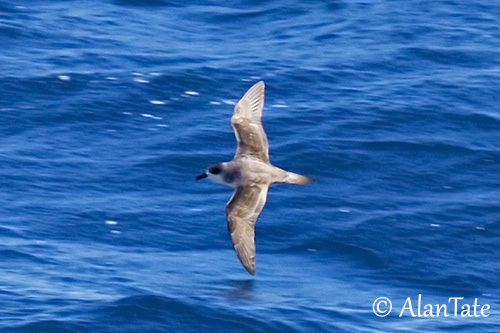
REPRODUCTION OF THIS SPECIES:
The Juan Fernandez Petrel returns to land to breed in October to November.
The egg-laying probably occurs from late December to early January. The young fledge between late May and early June.
This species breeds colonially, often with Stejneger's Petrel. It nests in burrows and sometimes on the ground, between 600 and 1,000 metres of elevation.
The female lays a single white egg, and both adults share the incubation during about 60 days, with shifts of 19-22 days. At hatching, the chick has grey-brown down, darker on the head and paler on the belly. The chick-rearing period lasts 90-100 days. The adults return to the burrow at dusk. The chick usually fledges in May and June.
PROTECTION / THREATS / STATUS:
The Juan Fernandez Petrel is threatened by invasive species such as cats, rats, dogs and goats. Predation by cats is thought to be causing population decline, both in adults and near-fledging chicks. Brown rats also prey on chicks. The goats involve degradation of the habitat and destruction of burrows. The dogs also impact the species.
But birds such as Variable Hawk, American Kestrel and Short-eared Owl are also known as predators of this petrel.
Habitat loss is sometimes caused by flash flooding destroying the burrows. Light pollution and climate change also represent a threat for the species.
The size of the population is estimated at least 3,000,000 individuals. It is declining due to predation.
The Juan Fernandez Petrel is currently classified as Vulnerable, with a very small breeding range.
